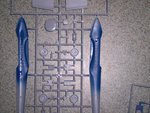vikingBerserker
Lieutenant General
User name: VikingBerserker
Name: David
Category: 2, Intermediate
Kit: Azur
Scale: 1/48th.
Accessories: Some scratch building
I'll be building the one pictered on the box art. The kit comes with PE Resin parts

The French Potez 631 night-fighter corresponded in many respects to the RAF's Bristol Blenheim, being very similar in size and performance (though somewhat lighter) as well as being conceived as a variation of a light bomber. The French aircraft was one of a family of design variations of the Potez 63 which had originated in a requirement issued in 1934 for a two/ three-seat 'multi-purpose' aircraft. Although a night-fighter prototype had flown in March 1937 as the Potez 631-0, French re-equipment policies were blurred by lack of purpose (being confused by the likely form of warfare being studied by Germany), with the result that orders for development aircraft included four-general purpose two/three-seat day/night fighters, three two-seat night-fighters, one light bomber, one reconnaissance aircraft and one close-support aircraft. Relatively little importance was placed on the Potez 631 night-fighter, and it was not until June 1938 that production orders totalling 207 were confirmed.
By 1 April 1939 the Armee de l'Air had taken delivery of 88 aircraft, of which 20 were in service; in May two night-fighter units, Groupes de Chasse de Nuit GCN III/l and II/4, and one day fighter unit, GC II/8, were equipped with about 30 aircraft; four other Potez 631s were serving at Djibouti. At the outbreak of war a total of 206 aircraft had been delivered, and the type had also joined GCN 1/13 and GCN 11/13, as well as seven escadres de chasse. Some aircraft were later transferred to the Aeronavale. When the German attack opened in the West the various Potez 631 units were in constant action both by day and night, although lack of radar prevented much success during the hours of darkness. In the first 11 days of the campaign Aeronavale's Flotille F 1C shot down 12 German aircraft for the loss of eight, but the Armee de l'Air night-fighter units were ordered to assume day ground-attack duties, losing heavily to enemy flak. Moreover, losses were exceptionally heavy to Allied guns and fighters as a result of the Potez 631's superficial similarity to the German Messerschmitt Bf 110; it has been estimated that as many as 30 of the French aircraft were shot down in error. In all, Potez 631 night-fighters destroyed a total of 29 German aircraft in the Battle of France, but for a loss of 93 of their own number. Of the remainder about 110 were in the Free French Zone (Vichy France) at the time of the armistice, but their number dwindled quickly because of a chronic lack of spares, although ECN 3/13 moved to Tunisia with a small number of Potez 631s in June 1941. from Potez 630/631 - fighter, fighter-bomber
Name: David
Category: 2, Intermediate
Kit: Azur
Scale: 1/48th.
Accessories: Some scratch building
I'll be building the one pictered on the box art. The kit comes with PE Resin parts
The French Potez 631 night-fighter corresponded in many respects to the RAF's Bristol Blenheim, being very similar in size and performance (though somewhat lighter) as well as being conceived as a variation of a light bomber. The French aircraft was one of a family of design variations of the Potez 63 which had originated in a requirement issued in 1934 for a two/ three-seat 'multi-purpose' aircraft. Although a night-fighter prototype had flown in March 1937 as the Potez 631-0, French re-equipment policies were blurred by lack of purpose (being confused by the likely form of warfare being studied by Germany), with the result that orders for development aircraft included four-general purpose two/three-seat day/night fighters, three two-seat night-fighters, one light bomber, one reconnaissance aircraft and one close-support aircraft. Relatively little importance was placed on the Potez 631 night-fighter, and it was not until June 1938 that production orders totalling 207 were confirmed.
By 1 April 1939 the Armee de l'Air had taken delivery of 88 aircraft, of which 20 were in service; in May two night-fighter units, Groupes de Chasse de Nuit GCN III/l and II/4, and one day fighter unit, GC II/8, were equipped with about 30 aircraft; four other Potez 631s were serving at Djibouti. At the outbreak of war a total of 206 aircraft had been delivered, and the type had also joined GCN 1/13 and GCN 11/13, as well as seven escadres de chasse. Some aircraft were later transferred to the Aeronavale. When the German attack opened in the West the various Potez 631 units were in constant action both by day and night, although lack of radar prevented much success during the hours of darkness. In the first 11 days of the campaign Aeronavale's Flotille F 1C shot down 12 German aircraft for the loss of eight, but the Armee de l'Air night-fighter units were ordered to assume day ground-attack duties, losing heavily to enemy flak. Moreover, losses were exceptionally heavy to Allied guns and fighters as a result of the Potez 631's superficial similarity to the German Messerschmitt Bf 110; it has been estimated that as many as 30 of the French aircraft were shot down in error. In all, Potez 631 night-fighters destroyed a total of 29 German aircraft in the Battle of France, but for a loss of 93 of their own number. Of the remainder about 110 were in the Free French Zone (Vichy France) at the time of the armistice, but their number dwindled quickly because of a chronic lack of spares, although ECN 3/13 moved to Tunisia with a small number of Potez 631s in June 1941. from Potez 630/631 - fighter, fighter-bomber
Last edited:




